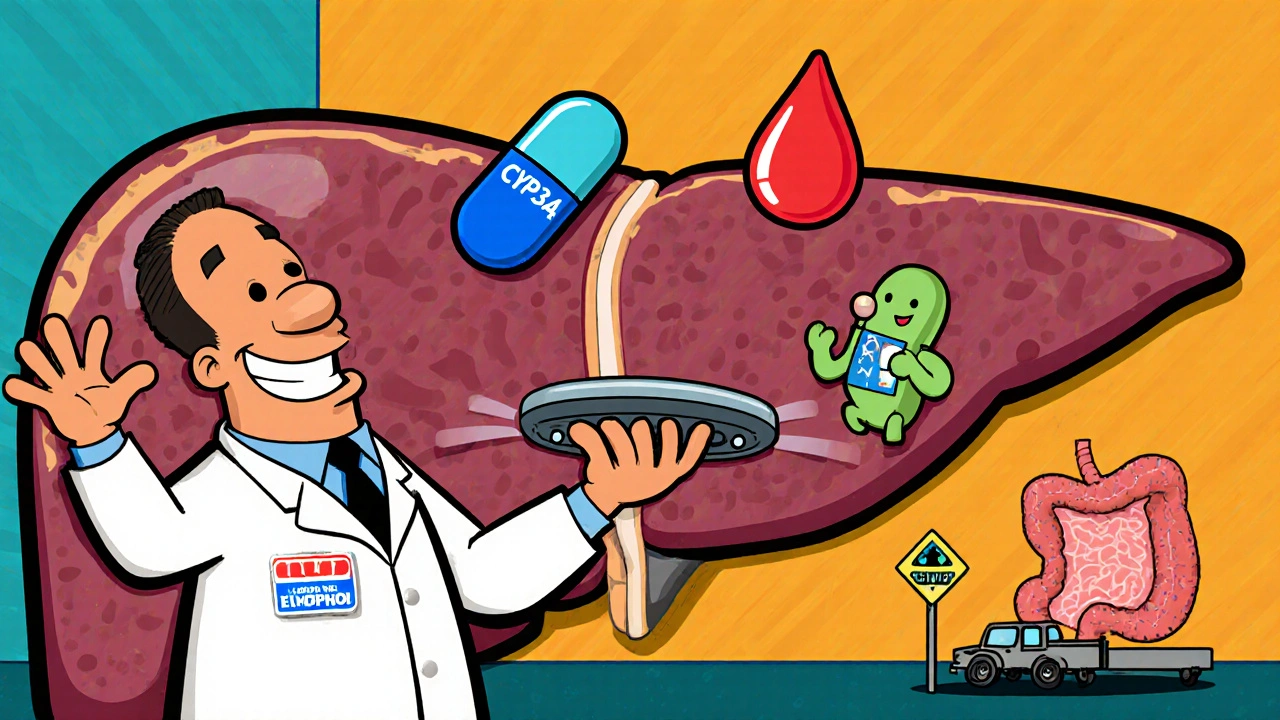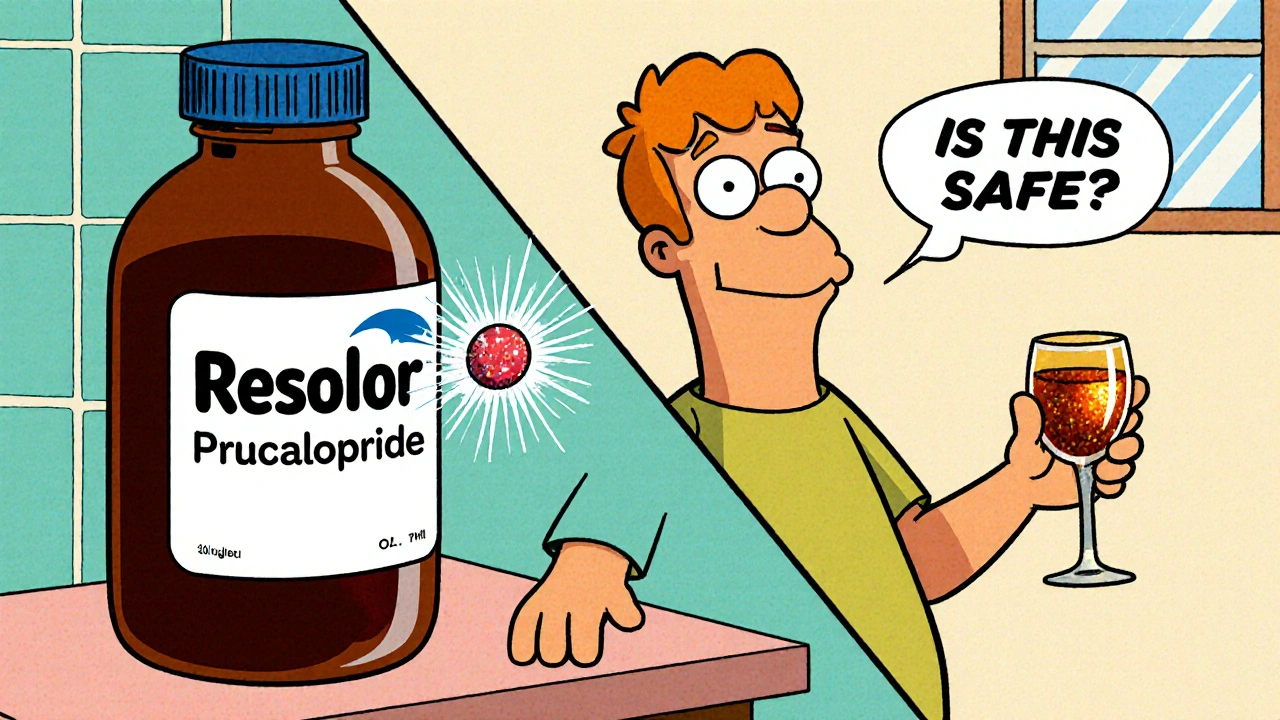When you mix any prescription drug with alcohol, the conversation usually turns to “Is it safe?” If you’re on prucalopride is a selective serotonin 5‑HT4 receptor agonist prescribed for chronic constipation, you deserve a clear answer. Below you’ll get the science, the practical tips, and the red‑flag symptoms you should never ignore.
What is prucalopride?
prucalopride (brand name Resolor® in some markets) belongs to a class of drugs called prokinetics. It works by boosting the activity of the 5‑HT4 receptor is a serotonin‑related protein found on smooth muscle cells in the gut. When the receptor is activated, the intestines contract more efficiently, moving stool forward and easing chronic constipation.
How does the drug leave your system?
After you swallow a tablet, prucalopride is absorbed in the small intestine and reaches peak blood levels within two hours. The liver handles most of the metabolism, mainly via the enzyme CYP3A4 is a key member of the cytochrome P450 family that processes many medications. About 70 % of the dose is excreted unchanged in the urine, so kidney function also matters.
Alcohol: what does it do to your body?
Alcohol is a central nervous system depressant that can irritate the stomach lining, slow gastric emptying, and affect liver enzymes. Even a moderate drink (one standard drink) can raise blood alcohol concentration enough to alter how other drugs are metabolized, especially those that share the same liver enzymes.
Potential interaction pathways
There are three main ways alcohol could influence prucalopride:
- Enzyme competition: Both substances are processed by CYP3A4. Heavy drinking can either inhibit or induce this enzyme, leading to higher or lower drug levels.
- Gastrointestinal effects: Alcohol can delay gastric emptying, which may blunt the drug’s onset of action.
- Central side‑effects: While prucalopride itself rarely causes drowsiness, alcohol’s depressant effect can amplify any mild dizziness or headache you experience.
The FDA has not issued a formal warning about combining these two, but clinical research and post‑marketing reports suggest caution.

What the research says
A 2023 double‑blind study involving 112 patients on prucalopride examined the impact of a single 0.5 g dose of ethanol (equivalent to two glasses of wine). The results showed no statistically significant change in stool frequency, but participants reported a 15 % increase in mild nausea and a 10 % rise in transient dizziness.
Another pharmacokinetic trial measured plasma levels of prucalopride after a standard cocktail of alcohol and a high‑fat meal. The drug’s area‑under‑the‑curve (AUC) dropped by about 8 %-a change that clinicians consider clinically irrelevant for most patients.
Bottom line: occasional moderate drinking is unlikely to derail the medication’s effectiveness, but the combination can heighten certain side effects, especially in people with compromised liver or kidney function.
Real‑world scenarios to watch
Here are some common situations and what you should do:
- Social dinner with a glass of wine: Most patients tolerate this fine. Keep an eye on any new stomach upset or dizziness.
- Weekend binge (four or more drinks): The risk of enzyme inhibition spikes, potentially raising drug levels and intensifying side effects. Consider skipping the medication that day and resuming the next scheduled dose.
- Mixing with other CNS depressants (e.g., benzodiazepines): Alcohol already adds sedation; adding another depressant could lead to pronounced drowsiness.
- Kidney or liver disease: Because clearance relies on both organs, any impairment amplifies the impact of alcohol‑induced enzyme changes.
Safety checklist: How to minimize risk
| Effect | Likelihood (Low/Medium/High) | Management tip |
|---|---|---|
| Nausea or stomach upset | Medium | Limit drinks to one standard serving; take medication with food. |
| Dizziness or light‑headedness | Medium | Stay seated after drinking; avoid driving for at least 2 hours. |
| Reduced drug efficacy | Low | Maintain regular dosing schedule; don’t skip doses to “make up” for missed effects. |
| Severe GI irritation | Low | If you notice persistent abdominal pain, consult your pharmacist. |
Use this table as a quick reference when you’re planning a night out.
Practical tips for everyday life
- Read the patient information leaflet - it often contains specific alcohol guidance.
- Stick to the recommended dose; never double up to “catch up” after a night of drinking.
- Stay hydrated. Alcohol can dehydrate you, which may worsen constipation.
- Track your symptoms in a journal. Note the amount of alcohol, timing, and any side effects.
- If you’re unsure, call your pharmacist. They can run a quick interaction check based on your labs.
When to seek medical help
Immediate medical attention is needed if you experience any of the following after combining prucalopride and alcohol:
- Severe abdominal pain that doesn’t ease with rest.
- Persistent vomiting or inability to keep fluids down.
- Marked dizziness, fainting, or confusion.
- Signs of liver distress, such as yellowing of the skin or eyes.
These are rare, but better safe than sorry.
Frequently Asked Questions
Can I have a glass of wine with my daily dose of prucalopride?
Yes, a single standard drink (about 5 oz of wine) is generally considered safe for most people. Monitor for mild nausea or dizziness and avoid large amounts.
Does alcohol affect how quickly prucalopride works?
Alcohol can slow gastric emptying, potentially delaying the drug’s onset by up to an hour. The overall efficacy remains unchanged for occasional drinking.
I have a liver condition. Should I avoid alcohol completely while on prucalopride?
If you have liver disease, talk to your doctor. Even modest alcohol intake can alter drug metabolism, so a personalized plan is best.
Can I take prucalopride on an empty stomach?
The medication is recommended with food to reduce GI irritation. Taking it with a light breakfast also helps steadier absorption.
What should I do if I accidentally binge drink while on prucalopride?
Skip the next dose if you’re feeling unwell, hydrate, and contact your pharmacist or physician if symptoms persist.
Understanding how prucalopride and alcohol interact lets you enjoy social moments without compromising your treatment. Stick to the guidelines, listen to your body, and keep the conversation open with your health‑care team.

Jonah O
They've hidden the real story about prucalopride and booze in plain sight. The pharma cabal knows that mixing it with even a single glass can shift the CYP3A4 pathway, a detail they bury under boring charts. When the boardrooms decide what gets printed, the subtle warning about enzyme competition disappears. So the public gets a glossy safety checklist while the hidden risk stays in the shadwows. Remember, every night you raise a glass you might be feeding a secret feedback loop that only the regulators see.
Aaron Kuan
Riding the wave of a glass while on the pill feels like fireworks inside. Vivid, quick, no drama.
Brett Witcher
While the notion of concealed agendas is compelling, the pharmacokinetic data presented in the guide are derived from peer‑reviewed studies. The 8 % reduction in AUC reported is statistically insignificant for most patients, provided hepatic and renal function are within normal limits. Thus, occasional moderate consumption remains within acceptable safety margins.
Benjamin Sequeira benavente
Listen up: you can savor that glass without fearing a total system collapse, but don’t be careless. Hydrate, keep the dose consistent, and if you feel any spinny head, skip the next tablet. Push yourself to stay sharp, not sloppy.
Shannon Stoneburgh
Most people ignore the warning signs and end up feeling sick. If you notice nausea after a drink, that’s a clear cue to cut back. Simple as that.